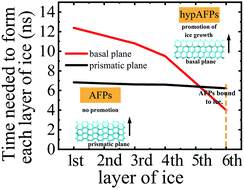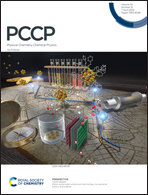Do antifreeze proteins generally possess the potential to promote ice growth?†
Abstract
The binding of antifreeze proteins (AFPs) to ice needs to be mediated by interfacial water molecules. Our previous study of the effect of AFPs on the dynamics of the interfacial water of freezing at its initial stage has shown that AFPs can promote the growth of ice before binding to it. However, whether different AFPs can promote the freezing of water molecules on the basal and the prismatic surfaces of ice still needs further study. In the present contribution, five representative natural AFPs with different structures and different activities that can be adsorbed on the basal and/or prismatic surfaces of ice are investigated at the atomic level. Our results show that the phenomenon of promoting the growth of ice crystals is not universal. Only hyperactive AFPs (hypAFPs) can promote the growth of the basal plane of ice, while moderately active AFPs cannot. Moreover, this significant promotion is not observed on the prismatic plane regardless of their activity. Further analysis indicates that this promotion may result from the thicker ice/water interface of the basal plane, and the synergy of hypAFPs with ice crystals.



 Please wait while we load your content...
Please wait while we load your content...